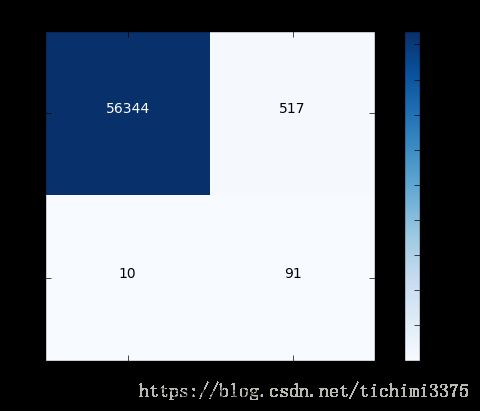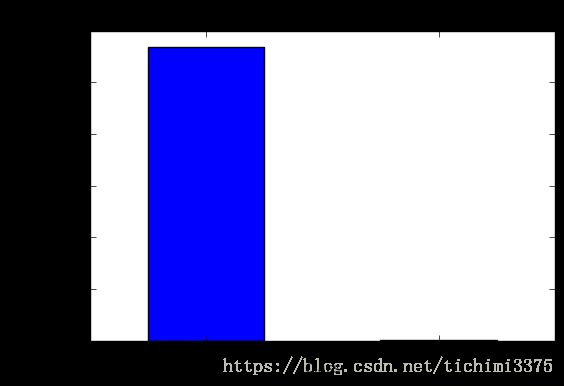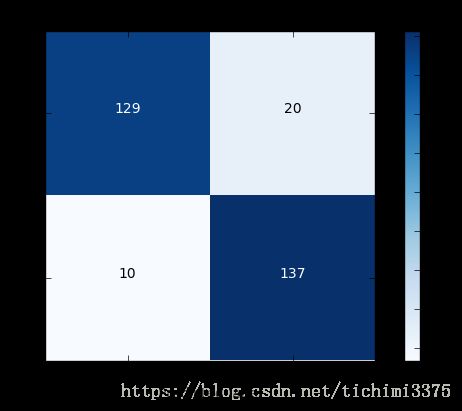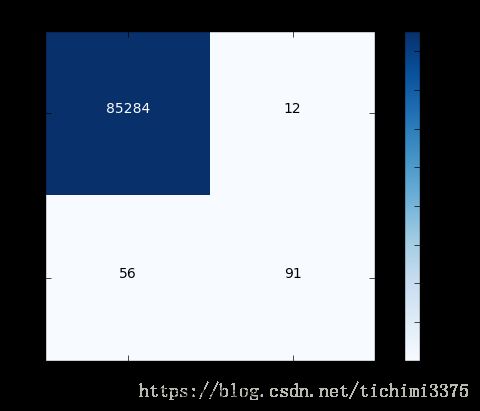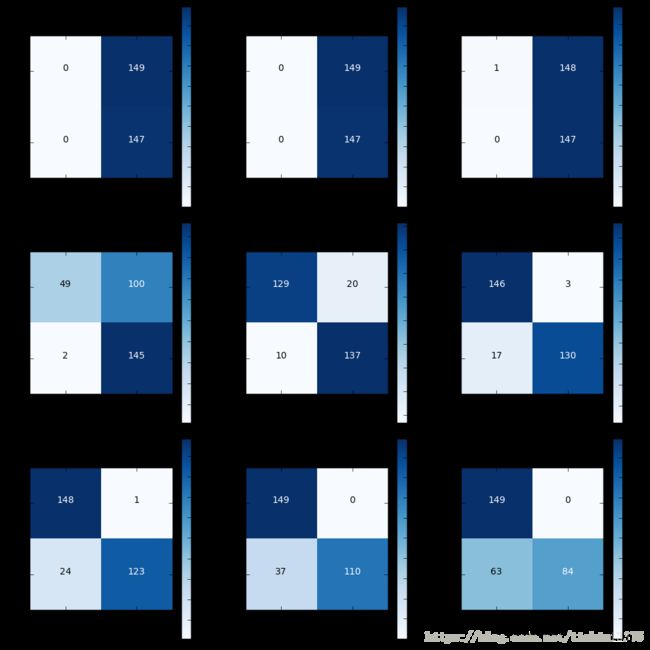人工智能学习笔记——案例实战信用卡欺诈检测(逻辑回归)
点击下载数据集
import pandas as pd
import matplotlib.pyplot as plt
import numpy as np
%matplotlib inlinedata = pd.read_csv("creditcard.csv")
data.head()#查看样本是否平衡
count_classes = pd.value_counts(data['Class'], sort = True).sort_index()
count_classes.plot(kind = 'bar')
plt.title("Fraud class histogram")
plt.xlabel("Class")
plt.ylabel("Frequency")显然样本不平衡,现在有两种策略来平衡样本,一种是下采样策略,让0和1样本一样少;另外一种是过采样策略,让1样本生成到与0同样多
另外Time列数据用不到,Amount列的数据起伏较大,在机器学习过程中可能误以为数值大的权重较大,故需要进行标准化或者归一化:
from sklearn.preprocessing import StandardScaler
data['normAmount'] = StandardScaler().fit_transform(data['Amount'].reshape(-1, 1))
data = data.drop(['Time','Amount'],axis=1)
data.head()#下采样策略
X = data.ix[:, data.columns != 'Class']
y = data.ix[:, data.columns == 'Class']
# Number of data points in the minority class
number_records_fraud = len(data[data.Class == 1])
fraud_indices = np.array(data[data.Class == 1].index)
# Picking the indices of the normal classes
normal_indices = data[data.Class == 0].index
# Out of the indices we picked, randomly select "x" number (number_records_fraud)
random_normal_indices = np.random.choice(normal_indices, number_records_fraud, replace = False)
random_normal_indices = np.array(random_normal_indices)
# Appending the 2 indices
under_sample_indices = np.concatenate([fraud_indices,random_normal_indices])
# Under sample dataset
under_sample_data = data.iloc[under_sample_indices,:]
X_undersample = under_sample_data.ix[:, under_sample_data.columns != 'Class']
y_undersample = under_sample_data.ix[:, under_sample_data.columns == 'Class']
# Showing ratio
print("Percentage of normal transactions: ", len(under_sample_data[under_sample_data.Class == 0])/len(under_sample_data))
print("Percentage of fraud transactions: ", len(under_sample_data[under_sample_data.Class == 1])/len(under_sample_data))
print("Total number of transactions in resampled data: ", len(under_sample_data))Percentage of normal transactions: 0.5 Percentage of fraud transactions: 0.5 Total number of transactions in resampled data: 984#交叉验证
from sklearn.cross_validation import train_test_split
# Whole dataset
X_train, X_test, y_train, y_test = train_test_split(X,y,test_size = 0.3, random_state = 0)
print("Number transactions train dataset: ", len(X_train))
print("Number transactions test dataset: ", len(X_test))
print("Total number of transactions: ", len(X_train)+len(X_test))
# Undersampled dataset
X_train_undersample, X_test_undersample, y_train_undersample, y_test_undersample = train_test_split(X_undersample
,y_undersample
,test_size = 0.3
,random_state = 0)
print("")
print("Number transactions train dataset: ", len(X_train_undersample))
print("Number transactions test dataset: ", len(X_test_undersample))
print("Total number of transactions: ", len(X_train_undersample)+len(X_test_undersample))Number transactions train dataset: 199364 Number transactions test dataset: 85443 Total number of transactions: 284807 Number transactions train dataset: 688 Number transactions test dataset: 296 Total number of transactions: 984
#模型评估方法
#Recall = TP/(TP+FN)
from sklearn.linear_model import LogisticRegression
from sklearn.cross_validation import KFold, cross_val_score
from sklearn.metrics import confusion_matrix,recall_score,classification_report def printing_Kfold_scores(x_train_data,y_train_data):
fold = KFold(len(y_train_data),5,shuffle=False)
# Different C parameters
#正则化惩罚项
c_param_range = [0.01,0.1,1,10,100]
results_table = pd.DataFrame(index = range(len(c_param_range),2), columns = ['C_parameter','Mean recall score'])
results_table['C_parameter'] = c_param_range
# the k-fold will give 2 lists: train_indices = indices[0], test_indices = indices[1]
j = 0
for c_param in c_param_range:
print('-------------------------------------------')
print('C parameter: ', c_param)
print('-------------------------------------------')
print('')
recall_accs = []
for iteration, indices in enumerate(fold,start=1):
# Call the logistic regression model with a certain C parameter
lr = LogisticRegression(C = c_param, penalty = 'l1')
# Use the training data to fit the model. In this case, we use the portion of the fold to train the model
# with indices[0]. We then predict on the portion assigned as the 'test cross validation' with indices[1]
lr.fit(x_train_data.iloc[indices[0],:],y_train_data.iloc[indices[0],:].values.ravel())
# Predict values using the test indices in the training data
y_pred_undersample = lr.predict(x_train_data.iloc[indices[1],:].values)
# Calculate the recall score and append it to a list for recall scores representing the current c_parameter
recall_acc = recall_score(y_train_data.iloc[indices[1],:].values,y_pred_undersample)
recall_accs.append(recall_acc)
print('Iteration ', iteration,': recall score = ', recall_acc)
# The mean value of those recall scores is the metric we want to save and get hold of.
results_table.ix[j,'Mean recall score'] = np.mean(recall_accs)
j += 1
print('')
print('Mean recall score ', np.mean(recall_accs))
print('')
best_c = results_table.loc[results_table['Mean recall score'].idxmax()]['C_parameter']
# Finally, we can check which C parameter is the best amongst the chosen.
print('*********************************************************************************')
print('Best model to choose from cross validation is with C parameter = ', best_c)
print('*********************************************************************************')
return best_cbest_c = printing_Kfold_scores(X_train_undersample,y_train_undersample)------------------------------------------- C parameter: 0.01 ------------------------------------------- Iteration 1 : recall score = 0.958904109589 Iteration 2 : recall score = 0.917808219178 Iteration 3 : recall score = 1.0 Iteration 4 : recall score = 0.972972972973 Iteration 5 : recall score = 0.954545454545 Mean recall score 0.960846151257 ------------------------------------------- C parameter: 0.1 ------------------------------------------- Iteration 1 : recall score = 0.835616438356 Iteration 2 : recall score = 0.86301369863 Iteration 3 : recall score = 0.915254237288 Iteration 4 : recall score = 0.932432432432 Iteration 5 : recall score = 0.878787878788 Mean recall score 0.885020937099 ------------------------------------------- C parameter: 1 ------------------------------------------- Iteration 1 : recall score = 0.835616438356 Iteration 2 : recall score = 0.86301369863 Iteration 3 : recall score = 0.966101694915 Iteration 4 : recall score = 0.945945945946 Iteration 5 : recall score = 0.893939393939 Mean recall score 0.900923434357 ------------------------------------------- C parameter: 10 ------------------------------------------- Iteration 1 : recall score = 0.849315068493 Iteration 2 : recall score = 0.86301369863 Iteration 3 : recall score = 0.966101694915 Iteration 4 : recall score = 0.959459459459 Iteration 5 : recall score = 0.893939393939 Mean recall score 0.906365863087 ------------------------------------------- C parameter: 100 ------------------------------------------- Iteration 1 : recall score = 0.86301369863 Iteration 2 : recall score = 0.86301369863 Iteration 3 : recall score = 0.966101694915 Iteration 4 : recall score = 0.959459459459 Iteration 5 : recall score = 0.893939393939 Mean recall score 0.909105589115 ********************************************************************************* Best model to choose from cross validation is with C parameter = 0.01 *********************************************************************************
#混淆矩阵
def plot_confusion_matrix(cm, classes,
title='Confusion matrix',
cmap=plt.cm.Blues):
"""
This function prints and plots the confusion matrix.
"""
plt.imshow(cm, interpolation='nearest', cmap=cmap)
plt.title(title)
plt.colorbar()
tick_marks = np.arange(len(classes))
plt.xticks(tick_marks, classes, rotation=0)
plt.yticks(tick_marks, classes)
thresh = cm.max() / 2.
for i, j in itertools.product(range(cm.shape[0]), range(cm.shape[1])):
plt.text(j, i, cm[i, j],
horizontalalignment="center",
color="white" if cm[i, j] > thresh else "black")
plt.tight_layout()
plt.ylabel('True label')
plt.xlabel('Predicted label')#下采样策略混淆矩阵
import itertools
lr = LogisticRegression(C = best_c, penalty = 'l1')
lr.fit(X_train_undersample,y_train_undersample.values.ravel())
y_pred_undersample = lr.predict(X_test_undersample.values)
# Compute confusion matrix
cnf_matrix = confusion_matrix(y_test_undersample,y_pred_undersample)
np.set_printoptions(precision=2)
print("Recall metric in the testing dataset: ", cnf_matrix[1,1]/(cnf_matrix[1,0]+cnf_matrix[1,1]))
# Plot non-normalized confusion matrix
class_names = [0,1]
plt.figure()
plot_confusion_matrix(cnf_matrix
, classes=class_names
, title='Confusion matrix')
plt.show()#完整数据集混淆矩阵
lr = LogisticRegression(C = best_c, penalty = 'l1')
lr.fit(X_train_undersample,y_train_undersample.values.ravel())
y_pred = lr.predict(X_test.values)
# Compute confusion matrix
cnf_matrix = confusion_matrix(y_test,y_pred)
np.set_printoptions(precision=2)
print("Recall metric in the testing dataset: ", cnf_matrix[1,1]/(cnf_matrix[1,0]+cnf_matrix[1,1]))
# Plot non-normalized confusion matrix
class_names = [0,1]
plt.figure()
plot_confusion_matrix(cnf_matrix
, classes=class_names
, title='Confusion matrix')
plt.show()best_c = printing_Kfold_scores(X_train,y_train)------------------------------------------- C parameter: 0.01 ------------------------------------------- Iteration 1 : recall score = 0.492537313433 Iteration 2 : recall score = 0.602739726027 Iteration 3 : recall score = 0.683333333333 Iteration 4 : recall score = 0.569230769231 Iteration 5 : recall score = 0.45 Mean recall score 0.559568228405 ------------------------------------------- C parameter: 0.1 ------------------------------------------- Iteration 1 : recall score = 0.567164179104 Iteration 2 : recall score = 0.616438356164 Iteration 3 : recall score = 0.683333333333 Iteration 4 : recall score = 0.584615384615 Iteration 5 : recall score = 0.525 Mean recall score 0.595310250644 ------------------------------------------- C parameter: 1 ------------------------------------------- Iteration 1 : recall score = 0.55223880597 Iteration 2 : recall score = 0.616438356164 Iteration 3 : recall score = 0.716666666667 Iteration 4 : recall score = 0.615384615385 Iteration 5 : recall score = 0.5625 Mean recall score 0.612645688837 ------------------------------------------- C parameter: 10 ------------------------------------------- Iteration 1 : recall score = 0.55223880597 Iteration 2 : recall score = 0.616438356164 Iteration 3 : recall score = 0.733333333333 Iteration 4 : recall score = 0.615384615385 Iteration 5 : recall score = 0.575 Mean recall score 0.61847902217 ------------------------------------------- C parameter: 100 ------------------------------------------- Iteration 1 : recall score = 0.55223880597 Iteration 2 : recall score = 0.616438356164 Iteration 3 : recall score = 0.733333333333 Iteration 4 : recall score = 0.615384615385 Iteration 5 : recall score = 0.575 Mean recall score 0.61847902217 ********************************************************************************* Best model to choose from cross validation is with C parameter = 10.0 *********************************************************************************
lr = LogisticRegression(C = best_c, penalty = 'l1')
lr.fit(X_train,y_train.values.ravel())
y_pred_undersample = lr.predict(X_test.values)
# Compute confusion matrix
cnf_matrix = confusion_matrix(y_test,y_pred_undersample)
np.set_printoptions(precision=2)
print("Recall metric in the testing dataset: ", cnf_matrix[1,1]/(cnf_matrix[1,0]+cnf_matrix[1,1]))
# Plot non-normalized confusion matrix
class_names = [0,1]
plt.figure()
plot_confusion_matrix(cnf_matrix
, classes=class_names
, title='Confusion matrix')
plt.show()#逻辑回归阈值对结果的影响
lr = LogisticRegression(C = 0.01, penalty = 'l1')
lr.fit(X_train_undersample,y_train_undersample.values.ravel())
y_pred_undersample_proba = lr.predict_proba(X_test_undersample.values)
thresholds = [0.1,0.2,0.3,0.4,0.5,0.6,0.7,0.8,0.9]
plt.figure(figsize=(10,10))
j = 1
for i in thresholds:
y_test_predictions_high_recall = y_pred_undersample_proba[:,1] > i
plt.subplot(3,3,j)
j += 1
# Compute confusion matrix
cnf_matrix = confusion_matrix(y_test_undersample,y_test_predictions_high_recall)
np.set_printoptions(precision=2)
print("Recall metric in the testing dataset: ", cnf_matrix[1,1]/(cnf_matrix[1,0]+cnf_matrix[1,1]))
# Plot non-normalized confusion matrix
class_names = [0,1]
plot_confusion_matrix(cnf_matrix
, classes=class_names
, title='Threshold >= %s'%i) Recall metric in the testing dataset: 1.0 Recall metric in the testing dataset: 1.0 Recall metric in the testing dataset: 1.0 Recall metric in the testing dataset: 0.986394557823 Recall metric in the testing dataset: 0.931972789116 Recall metric in the testing dataset: 0.884353741497 Recall metric in the testing dataset: 0.836734693878 Recall metric in the testing dataset: 0.748299319728 Recall metric in the testing dataset: 0.571428571429
#过采样策略、SMOTE生成策略
import pandas as pd
from imblearn.over_sampling import SMOTE
from sklearn.ensemble import RandomForestClassifier
from sklearn.metrics import confusion_matrix
from sklearn.model_selection import train_test_splitcredit_cards=pd.read_csv('creditcard.csv')
columns=credit_cards.columns
# The labels are in the last column ('Class'). Simply remove it to obtain features columns
features_columns=columns.delete(len(columns)-1)
features=credit_cards[features_columns]
labels=credit_cards['Class']features_train, features_test, labels_train, labels_test = train_test_split(features,
labels,
test_size=0.2,
random_state=0)oversampler=SMOTE(random_state=0)
os_features,os_labels=oversampler.fit_sample(features_train,labels_train)len(os_labels[os_labels==1])227454
os_features = pd.DataFrame(os_features)
os_labels = pd.DataFrame(os_labels)
best_c = printing_Kfold_scores(os_features,os_labels)------------------------------------------- C parameter: 0.01 ------------------------------------------- Iteration 1 : recall score = 0.890322580645 Iteration 2 : recall score = 0.894736842105 Iteration 3 : recall score = 0.968861347792 Iteration 4 : recall score = 0.957595541926 Iteration 5 : recall score = 0.958430881173 Mean recall score 0.933989438728 ------------------------------------------- C parameter: 0.1 ------------------------------------------- Iteration 1 : recall score = 0.890322580645 Iteration 2 : recall score = 0.894736842105 Iteration 3 : recall score = 0.970410534469 Iteration 4 : recall score = 0.959980655302 Iteration 5 : recall score = 0.960178498807 Mean recall score 0.935125822266 ------------------------------------------- C parameter: 1 ------------------------------------------- Iteration 1 : recall score = 0.890322580645 Iteration 2 : recall score = 0.894736842105 Iteration 3 : recall score = 0.970454796946 Iteration 4 : recall score = 0.96014552489 Iteration 5 : recall score = 0.960596168431 Mean recall score 0.935251182603 ------------------------------------------- C parameter: 10 ------------------------------------------- Iteration 1 : recall score = 0.890322580645 Iteration 2 : recall score = 0.894736842105 Iteration 3 : recall score = 0.97065397809 Iteration 4 : recall score = 0.960343368396 Iteration 5 : recall score = 0.960530220596 Mean recall score 0.935317397966 ------------------------------------------- C parameter: 100 ------------------------------------------- Iteration 1 : recall score = 0.890322580645 Iteration 2 : recall score = 0.894736842105 Iteration 3 : recall score = 0.970543321899 Iteration 4 : recall score = 0.960211472725 Iteration 5 : recall score = 0.960903924995 Mean recall score 0.935343628474 ********************************************************************************* Best model to choose from cross validation is with C parameter = 100.0 *********************************************************************************
lr = LogisticRegression(C = best_c, penalty = 'l1')
lr.fit(os_features,os_labels.values.ravel())
y_pred = lr.predict(features_test.values)
# Compute confusion matrix
cnf_matrix = confusion_matrix(labels_test,y_pred)
np.set_printoptions(precision=2)
print("Recall metric in the testing dataset: ", cnf_matrix[1,1]/(cnf_matrix[1,0]+cnf_matrix[1,1]))
# Plot non-normalized confusion matrix
class_names = [0,1]
plt.figure()
plot_confusion_matrix(cnf_matrix
, classes=class_names
, title='Confusion matrix')
plt.show()